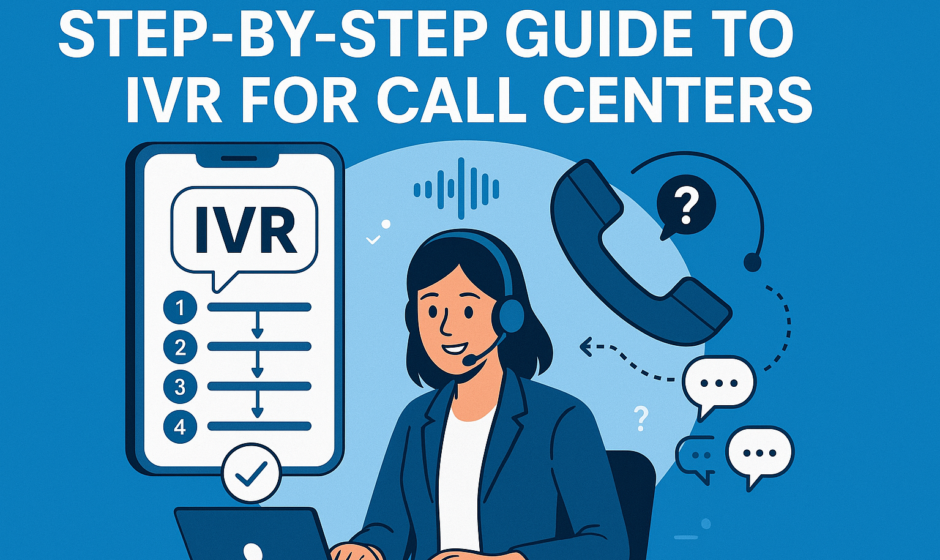IVR for Call Center is one of the most essential components of a modern call center. It helps businesses streamline call management, reduce wait times, and improve customer satisfaction. Whether you’re setting up a new call center or upgrading an existing one, implementing IVR Service correctly is key to providing excellent customer service.
In this blog, we will guide you through a step-by-step process for setting up IVR for Your Call Center, ensuring smooth integration and maximum impact.
What Is IVR?
An IVR System is an automated phone system that interacts with callers through voice prompts or keypad inputs. It enables customers to route their calls to the correct department without requiring a live agent.
Example:
“Press 1 for Sales, Press 2 for Support, Press 3 for Billing…”
Why Is IVR Important for Call Centers?
Here are some key benefits of using IVR Service in your call center:
- Improved customer experience with fast call routing
- Reduced agent workload by handling repetitive queries automatically
- 24/7 service through pre-recorded options
- Higher FCR (First Call Resolution) and lower call abandonment
- Better resource allocation for peak hours
Step-by-Step Guide to Set Up IVR
Setting up an IVR Service doesn’t have to be complex. Here’s a simplified step-by-step process you can follow:
Step 1: Define Your Call Flow
Start by understanding your customer journey. What are the most common queries? Which departments get the most calls?
Action Points:
- Identify all call purposes (e.g., Sales, Support, Returns, Billing).
- Map out the typical call path.
- Decide whether you need a single-level or multi-level IVR.
Tip: Keep the flow short. Ideally, no more than 3 levels deep.
Step 2: Choose the Right IVR Software
There are various IVR solutions available, from cloud-based to on-premise systems. Choose one that integrates well with your call center software and supports your business needs.
Look for:
- Call routing flexibility
- Cloud integration
- CRM compatibility
- Real-time analytics and reporting
- Voice recognition (if needed)
Popular IVR Software Options:
SanCCS, Five9, Genesys Cloud, Avaya, Freshcaller
Step 3: Record Clear Voice Prompts
The voice prompts are the heart of your IVR Service. Use a professional voice (human or AI-generated) and ensure the instructions are short, clear, and friendly.
Best Practices:
- Speak slowly and clearly.
- Use natural, conversational language.
- Offer an option to speak with a live agent.
Example:
“Hello! Welcome to [Company Name]. For Sales, press 1. For Customer Support, press 2…”
Step 4: Configure Routing Rules
This step involves defining how calls will be routed based on the input from the caller.
Options to configure:
- Time-based routing: Route calls differently during business hours and off-hours.
- Skill-based routing: Connect the caller to the agent with the right expertise.
- Priority-based routing: High-value customers get priority service.
- Location-based routing: Route calls based on the caller’s region.
Step 5: Set Up Failover Options
Sometimes calls may not connect as expected. A smart IVR system should have fallback mechanisms to avoid customer frustration.
Include:
- Option to leave a voicemail
- Automatic call-back option
- Redirect to a backup agent or support team.
- Error message for invalid inputs with the retry option
Step 6: Test the IVR Thoroughly
Before going live, test the system internally and with pilot customers.
Checklist:
- Test all menu options and call flows
- Check voice clarity and message accuracy.
- Ensure routing is working as expected.
- Measure response time and error handling.
- Test under high call volumes
Use feedback from internal testing to refine your scripts and call logic.
Step 7: Go Live and Monitor Performance
Once testing is successful, go live. But your job doesn’t end here. Use performance reports to make data-driven improvements.
Track metrics like:
- Call abandonment rate
- Average call handling time
- First call resolution (FCR)
- Menu option usage
- Call volume by department
Use this data to update your IVR system regularly and remove unused options.
Also visit: What is a Cloud Data Warehouse? A Complete Guide
Tips for a Successful IVR Setup
- Keep it simple: Too many options confuse callers.
- Provide an agent option early: Not everyone wants to talk to a machine.
- Use personalized greetings: Make the customer feel recognized.
- Support multiple languages: Especially useful for global or regional businesses.
- Update regularly: Business goals and customer behavior evolve over time.


